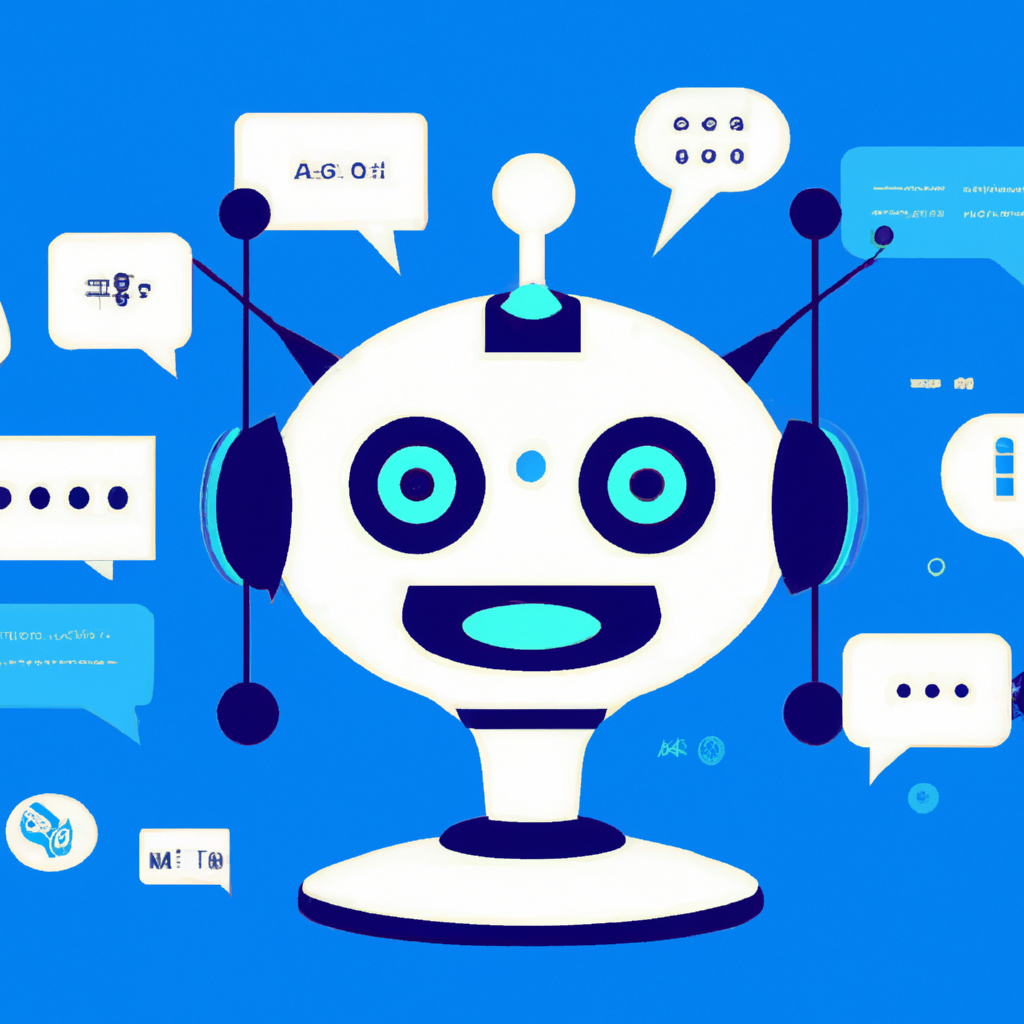Looking to boost your sales and conversion rates? Wondering how chatbots can play a role in your strategy? Look no further! In this article, we will explore the best ways to implement chatbots for sales and conversion. Whether you’re a seasoned expert or just starting out, this content will provide you with valuable insights and practical tips to optimize your chatbot usage. From crafting engaging content formats to incorporating effective SEO techniques, we’ve got you covered. So, grab a cup of coffee and let’s dive into the world of chatbots!

Identifying the Right Use Cases for Chatbots
Chatbots can be a powerful tool for businesses when used in the right way. To ensure success, it is crucial to identify the right use cases for chatbots. By understanding your customers’ needs and intentions, you can tailor the chatbot experience to meet their expectations.
Segmenting Customers Based on Intent
One effective use case for chatbots in sales and conversion is segmenting customers based on their intent. By analyzing customer interactions, chatbots can categorize them into different segments based on the actions they take and the questions they ask. This segmentation allows businesses to personalize their messaging and offers to each customer segment, increasing the likelihood of a successful conversion.
Automating Lead Qualification
Chatbots can also be used to automate the lead qualification process. By asking targeted questions and collecting relevant information, chatbots can quickly determine whether a lead is likely to convert or not. This automation saves valuable time for the sales team, allowing them to focus on qualified leads and improve their conversion rates.
Assisting with Product Selection
Another way to implement chatbots for sales and conversion is by assisting customers with product selection. Chatbots can ask customers about their preferences, needs, and budget to offer personalized product recommendations. This guidance helps customers make informed decisions, increasing the chances of a successful sale.
Handling Frequently Asked Questions
Chatbots are excellent for handling frequently asked questions (FAQs). By providing instant responses to common queries, chatbots can save time for both customers and sales representatives. This quick and efficient support helps build trust with customers and can lead to higher conversion rates.
Choosing the Right Chatbot Platform
Once you have identified the use cases for your chatbot, it is essential to choose the right platform to implement it effectively. Consider the following factors when evaluating different chatbot platforms.
Evaluating Features and Capabilities
When choosing a chatbot platform, consider the features and capabilities it offers. Look for platforms that provide natural language processing, advanced analytics, and integration with other systems. These features will ensure that your chatbot can deliver a seamless and effective conversational experience.
Considering Integration Options
Integration is crucial when implementing chatbots for sales and conversion. Ensure that the chatbot platform can integrate with your existing CRM, marketing automation, and other sales tools. This integration allows for a smooth flow of data and ensures that your chatbot can provide accurate and personalized responses to customers.
Assessing Scalability and Reliability
Scalability and reliability are critical factors to consider when choosing a chatbot platform. You want a platform that can handle high volumes of traffic and conversations without compromising performance. Additionally, ensure that the platform has robust security measures in place to protect customer data.

Designing a Conversational Flow
To maximize the effectiveness of your chatbot in sales and conversion, it is essential to design a conversational flow that aligns with your customers’ goals and expectations.
Understanding User Goals and Expectations
Before designing the conversational flow, it is crucial to understand your users’ goals and expectations. Conduct user research or analyze customer data to identify common goals and pain points. This understanding will help you create a chatbot experience that addresses your customers’ needs and increases the chances of a successful conversion.
Creating a Natural Language Experience
To ensure a positive user experience, it is important to create a natural language experience with your chatbot. Focus on using conversational language and avoiding jargon or overly formal language. Additionally, consider incorporating emojis or GIFs to add personality and make the conversation more engaging.
Offering Personalization and Customization
Personalization is key to a successful chatbot experience. Consider using customer data to personalize the chatbot’s responses and recommendations. For example, if a customer has previously purchased a certain product, the chatbot can offer related products or discounts. This personalized approach creates a more tailored experience and increases the chances of conversion.
Providing Clear and Concise Responses
Clarity and conciseness are crucial when designing the conversational flow. Chatbot responses should be easy to understand and provide the necessary information without overwhelming the customer. Keep responses short and to the point, using bullet points or numbered lists when appropriate. Clear and concise responses help customers make informed decisions and can lead to higher conversion rates.
Enhancing Sales with Chatbots
Chatbots can play a significant role in enhancing sales and driving conversions. Here are several strategies to leverage chatbots effectively in the sales process.
Offering Product Recommendations
One way to enhance sales with chatbots is by offering personalized product recommendations. By analyzing customer data and preferences, chatbots can suggest relevant products that align with the customer’s interests and needs. This upselling technique can lead to increased order value and higher conversion rates.
Upselling and Cross-selling Strategies
In addition to product recommendations, chatbots can implement upselling and cross-selling strategies. By suggesting complementary products or upgrades, chatbots can encourage customers to make additional purchases. These strategies can increase the average order value and maximize revenue for the business.
Implementing Clear Call-to-Actions
Clear call-to-actions (CTAs) are essential in any sales process, and chatbots can help facilitate this. By incorporating persuasive CTAs in their conversations, chatbots can guide customers towards the next step in the sales funnel. Whether it’s signing up for a newsletter, scheduling a demo, or making a purchase, clear CTAs can increase the conversion rate.
Integrating with Payment Gateways
To streamline the sales process, it is crucial to integrate chatbots with payment gateways. This integration allows customers to make purchases directly within the chatbot conversation, eliminating friction and simplifying the buying experience. Providing a seamless and convenient payment option can significantly impact conversion rates.

Leveraging Chatbots for Lead Generation
Chatbots can also be powerful tools for lead generation. Here are some strategies to leverage chatbots effectively in generating and nurturing leads.
Creating Engaging and Interactive Chat Experiences
To capture leads effectively, it is important to create engaging and interactive chat experiences. Use conversational language, ask open-ended questions, and provide interactive elements such as buttons and quick replies. This approach encourages visitors to engage with the chatbot and share their information, increasing the chances of lead capture.
Capturing Visitor Information
Chatbots can capture visitor information seamlessly and unobtrusively. By asking for contact details, preferences, or any other relevant information, chatbots can collect valuable data for lead generation. It is essential to ensure that the information collected aligns with your lead qualification criteria.
Qualifying Leads in Real Time
One of the key benefits of using chatbots for lead generation is the ability to qualify leads in real time. By asking targeted questions, chatbots can quickly determine if a lead meets the qualification criteria. This allows businesses to prioritize and focus their efforts on the most promising leads, increasing conversion rates.
Nurturing Leads via Drip Campaigns
After capturing leads, it is crucial to nurture them effectively. Chatbots can assist in this process by implementing drip campaigns. Drip campaigns involve sending a series of automated messages to leads over time, providing relevant information and offers. This nurturing process keeps leads engaged and increases the chances of conversion.
Monitoring, Analyzing, and Optimizing Chatbot Performance
To ensure the effectiveness of your chatbot in driving sales and conversions, it is essential to continuously monitor, analyze, and optimize its performance. Here are some key steps to take in this process.
Tracking Key Metrics and KPIs
To evaluate the performance of your chatbot, it is important to track key metrics and key performance indicators (KPIs). These metrics can include conversation completion rate, response time, conversion rate, and customer satisfaction. By monitoring these metrics, you can identify areas for improvement and make data-driven decisions to optimize your chatbot’s performance.
Utilizing Natural Language Processing for Insights
Natural language processing (NLP) can provide valuable insights into customer interactions with your chatbot. By analyzing the sentiment, intent, and context of conversations, NLP algorithms can reveal patterns and trends. These insights can help identify areas where the chatbot can be improved and optimized to drive better sales and conversions.
Collecting Customer Feedback
Customer feedback is a valuable source of information for optimizing your chatbot’s performance. Encourage customers to provide feedback on their chatbot experience and incorporate their suggestions into future iterations. This iterative approach ensures that your chatbot is continuously improving and meeting the changing needs of your customers.
Continuous Improvement through A/B Testing
A/B testing is an effective strategy for optimizing your chatbot’s performance. Test different variations of the chatbot’s conversational flow, CTAs, or response options and measure the results. By identifying the most effective options through A/B testing, you can refine your chatbot to maximize its sales and conversion potential.

Ensuring a Seamless Integration with the Sales Team
To fully leverage the power of chatbots for sales and conversion, it is crucial to ensure a seamless integration with the sales team. Here are some key steps to take in this process.
Aligning Objectives and Strategies
Alignment between the chatbot implementation team and the sales team is essential. Clearly communicate the objectives and strategies of the chatbot initiative to the sales team, ensuring they understand how the chatbot can support their sales efforts. Regular communication and collaboration between the teams will ensure a seamless integration.
Providing Training and Support
To ensure the sales team can effectively utilize the chatbot in their sales processes, provide comprehensive training and ongoing support. This training should cover how to interact with the chatbot, interpret the data it provides, and leverage its capabilities to drive sales and conversions. Ongoing support ensures that the sales team feels confident and comfortable using the chatbot.
Collaborating on Lead Handoff Processes
A smooth handoff process between the chatbot and the sales team is crucial for converting qualified leads. Collaborate with the sales team to define clear processes for lead handoff, ensuring that leads are properly qualified and transferred to sales representatives without delay. Clear communication between the chatbot and the sales team is key to a successful integration.
Ensuring Efficient Communication Channels
Efficient communication channels between the chatbot and the sales team are essential for seamless integration. Implement tools or systems that allow for real-time communication and collaboration, ensuring that the sales team can access relevant chatbot data and respond promptly to leads. Efficient communication channels enable the sales team to leverage the chatbot’s insights effectively and close deals.
Maintaining a Human Touch in Sales Conversations
While chatbots offer many benefits in sales and conversion, it is important to maintain a human touch in sales conversations. Here are some strategies to strike the right balance between automation and human interaction.
Using Hybrid Chatbot-Human Approaches
A hybrid approach that combines the capabilities of chatbots with human interaction can be effective in maintaining a human touch. Design chatbot conversations to seamlessly hand off to a human sales representative when necessary. This allows customers to get the benefits of automation while still having the option for personalized assistance when needed.
Providing Easy Access to Human Support
Make it easy for customers to access human support when they require it. Include clear and prominent options for live chat or phone support within the chatbot conversation. This ensures that customers have the option to speak to a real person when they need more personalized assistance.
Adding Warmth and Personality to Chatbot Conversations
Infuse your chatbot conversations with warmth and personality to create a more human-like experience. Use friendly and conversational language, and consider using emojis or GIFs to add a touch of personality. These elements help to establish a connection with customers and create a more engaging conversation.
Implementing Live Chat Integration
Integrating live chat capabilities into your chatbot can provide customers with the best of both worlds – automation and human support. When a chatbot is unable to answer a question or resolve an issue, it can seamlessly transfer the conversation to a live chat agent. This integration ensures that customers receive the assistance they need while still benefiting from the efficiency of the chatbot.

Measuring the ROI of Chatbot Implementation
Measuring the return on investment (ROI) of your chatbot implementation is crucial to understand its impact on sales and conversion. Here are some key metrics to consider when calculating the ROI of chatbots.
Calculating Cost Savings and Efficiency Gains
One aspect of measuring ROI is calculating the cost savings and efficiency gains achieved through chatbot implementation. Compare the time and resources saved by automating tasks and providing instant support with the cost of developing and maintaining the chatbot. This analysis will help determine the cost-effectiveness of the chatbot and its impact on the bottom line.
Evaluating Conversion Rate and Revenue Impact
An essential metric to consider when measuring ROI is the impact on conversion rates and revenue. Compare the conversion rates and revenue generated before and after implementing the chatbot. If the chatbot has led to an increase in conversion rates or revenue, it demonstrates its effectiveness in driving sales and justifies the investment.
Comparing Chatbot Performance with Traditional Sales Channels
To assess the impact of chatbots on sales and conversion, compare their performance with traditional sales channels. Analyze metrics such as average order value, customer acquisition cost, and customer satisfaction. If the chatbot outperforms traditional channels in these areas, it is an indication of its effectiveness in driving sales and conversions.
Assessing Customer Satisfaction and Retention
Customer satisfaction and retention are crucial factors in measuring the ROI of chatbot implementation. Analyze customer feedback, reviews, and retention rates to understand the impact of the chatbot on customer satisfaction. A happy and engaged customer base is more likely to convert and become repeat customers, which directly impacts revenue and ROI.
Staying Up-to-Date with Chatbot Trends and Innovations
To stay ahead in the rapidly evolving landscape of chatbots, it is important to stay up-to-date with the latest trends and innovations. Here are some areas to explore and leverage in your chatbot strategy.
Exploring AI Advancements in Natural Language Understanding
Artificial intelligence (AI) advancements in natural language understanding (NLU) are continuously improving the capabilities of chatbots. Stay informed about the latest NLU techniques and algorithms to enhance your chatbot’s ability to understand and respond to user inputs. This understanding leads to more effective conversations and higher conversion rates.
Embracing Voice-Based Chatbot Interfaces
Voice-based chatbot interfaces are becoming increasingly popular. Explore and experiment with voice-enabled chatbots to offer customers an alternative interaction method. Voice-based chatbots can provide a hands-free and convenient experience for users, contributing to a positive user experience and potential sales conversions.
Leveraging Chatbots in Social Media Sales
Social media platforms offer a unique opportunity to implement chatbots for sales and conversion. Explore ways to integrate chatbots into social media channels such as Facebook Messenger or WhatsApp. These integrations allow businesses to engage with customers directly on social media platforms, providing instant support and driving sales.
Integrating Chatbots with Virtual Reality Experiences
Virtual reality (VR) is a cutting-edge technology that can enhance the chatbot experience. Explore ways to integrate chatbots with VR experiences, allowing customers to interact with virtual sales representatives or experience products in a virtual environment. This immersive experience can significantly impact sales and conversions.
In conclusion, implementing chatbots for sales and conversion requires careful consideration of the use cases, choosing the right platform, designing an effective conversational flow, leveraging chatbots for lead generation, monitoring and optimizing performance, ensuring seamless integration with the sales team, maintaining a human touch, measuring ROI, and staying up-to-date with trends and innovations. By following these strategies and continuously improving your chatbot implementation, you can maximize its potential to drive sales and conversions for your business.
